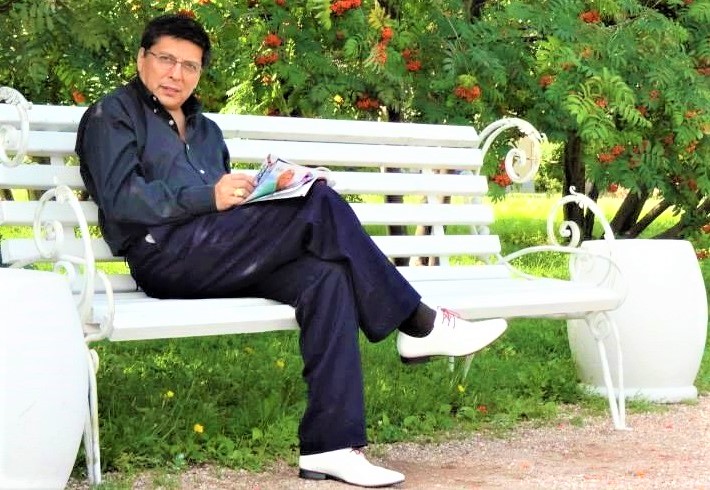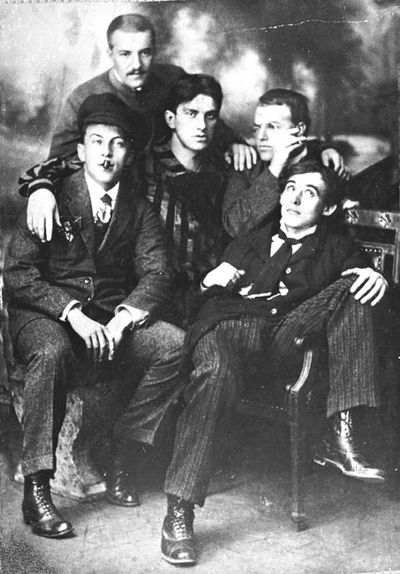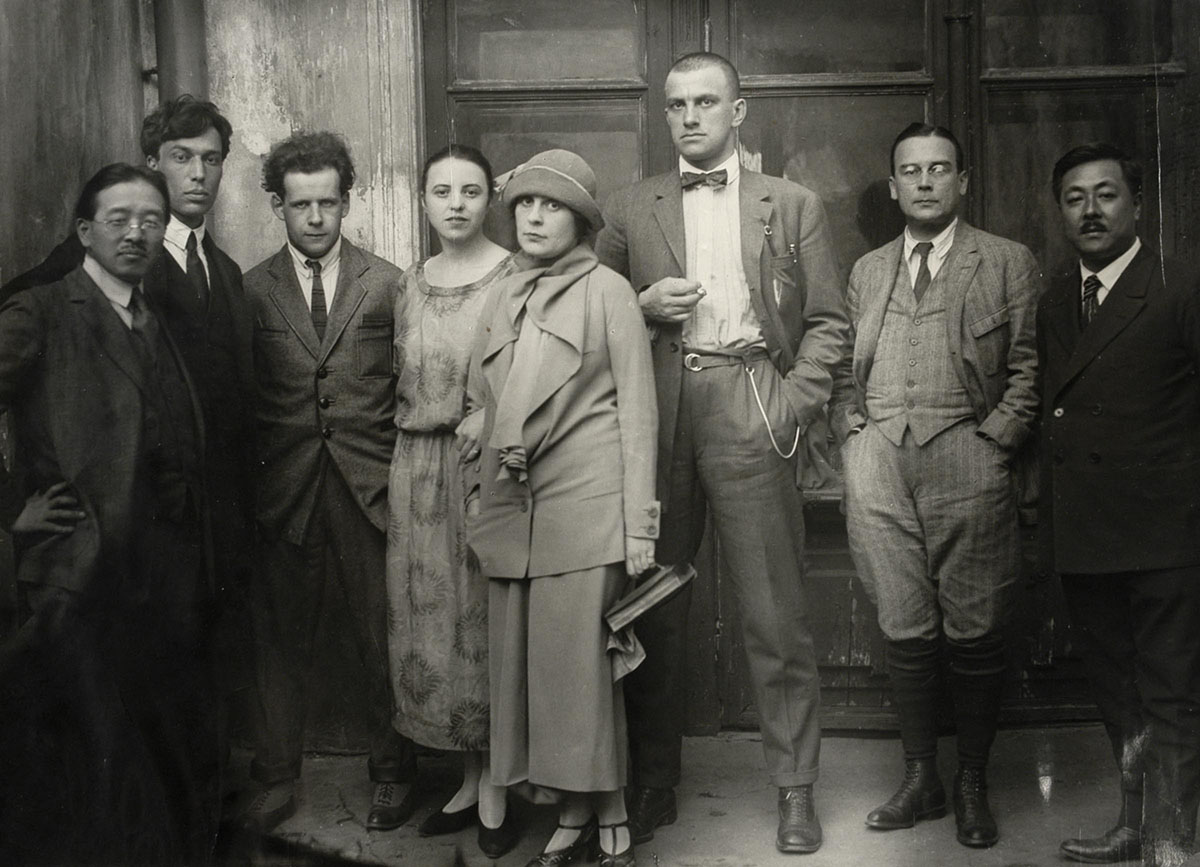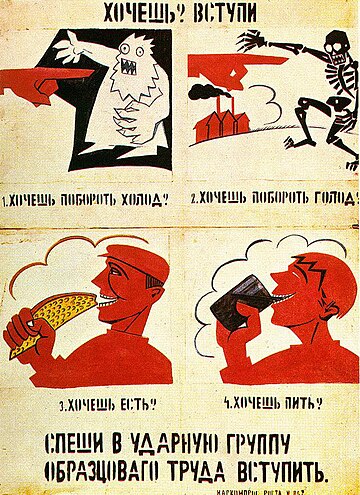Vladimir Vladimirovich Mayakovsky, was born the last of three children in Baghdati, Kutaisi Governorate, Georgia, then part of the Russian Empire. His father Vladimir Konstantinovich Mayakovsky, a local forester, belonged to a noble family and was a distant relative of the writer Grigory Danilevsky. Vladimir Vladimirovich's mother Alexandra Alexeyevna (née Pavlenko), was a housewife, looking after the children – a son and two daughters, Olga and Lyudmila (their brother Konstantin died at the age of three).[5]
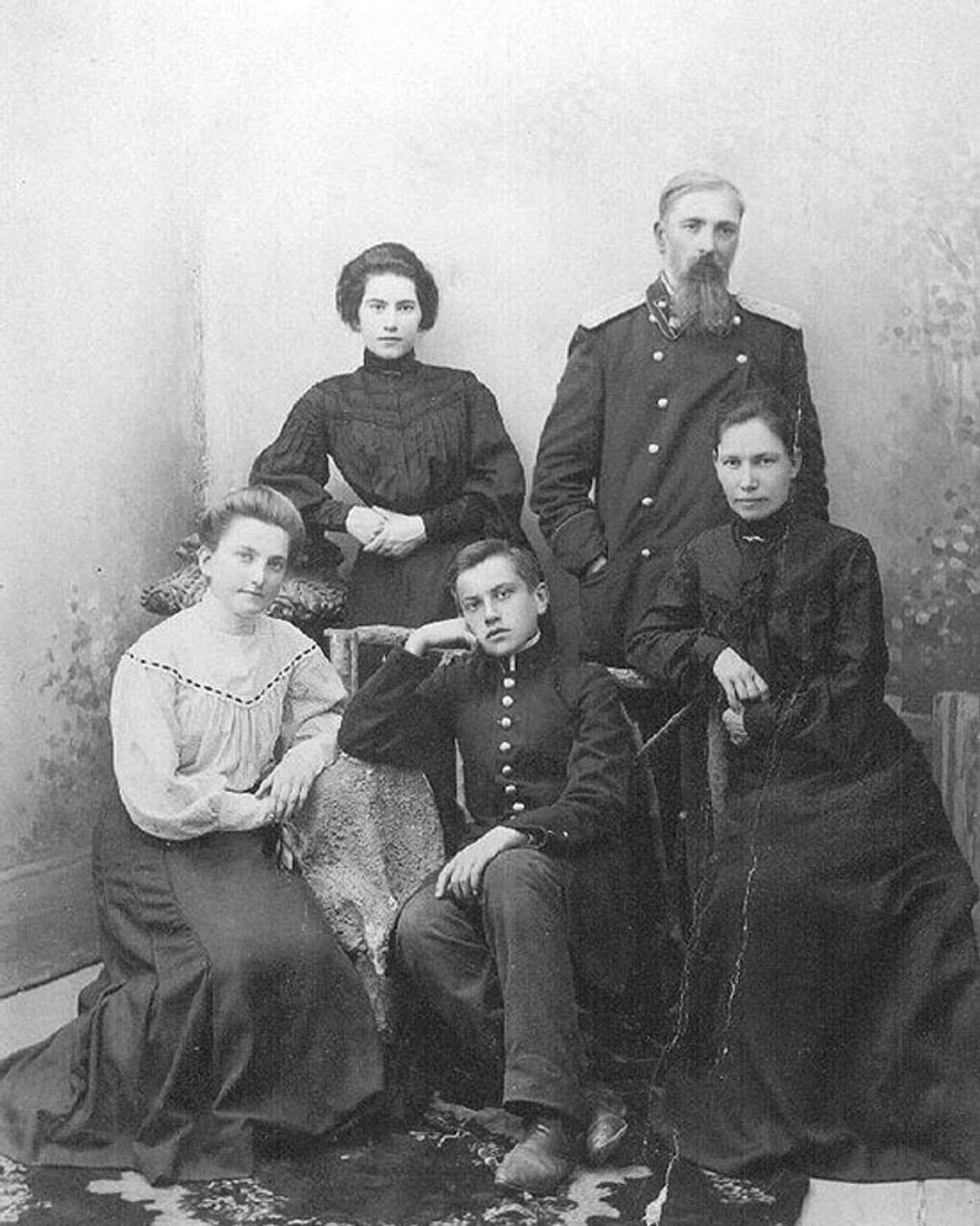 |
| The Mayakovskys in Kutaisi |
The family had Russian and Zaporozhian Cossack descent on their father's side and Ukrainian on their mother's.[6] At home the family spoke Russian. With his friends and at school Mayakovky used Georgian. "I was born in the Caucasus, my father is a Cossack, my mother is Ukrainian. My mother tongue is Georgian. Thus three cultures are united in me", he told the Prague newspaper Prager Presse in a 1927 interview.[7] Georgia for Mayakovsky remained the eternal symbol of beauty. "I know, it's nonsense, Eden and Paradise, but since people sang about them // It must have been Georgia, the joyful land, that those poets were having in mind", he wrote later.[5][8]
In 1902, Mayakovsky joined the Kutais gymnasium where, as a 14-year-old he took part in socialist demonstrations at the town of Kutaisi.[5] His mother, aware of his activities, apparently didn't mind. "People around warned us we were giving a young boy too much freedom. But I saw him developing according to the new trends, sympathized with him and pandered to his aspirations", she later remembered.[6] After the sudden and premature death of his father in 1906 (he pricked his finger with a rusty pin while filing papers and died of blood poisoning) the family — Mayakovsky, his mother, and his two sisters — moved to Moscow after selling all their movable property.[5][9]
In July 1906 Mayakovsky, joined the 4th form of the Moscow's 5th Classic gymnasium and soon developed a passion for Marxist literature. "Never cared for fiction. For me it was philosophy, Hegel, natural sciences, but first and foremost, Marxism. There'd be no higher art for me than "The Foreword" by Marx, he recalled in the 1920s in his autobiography I, Myself.[10]In 1907 Mayakovsky became a member of his gymnasium's underground Social Democrats' circle, taking part in numerous activities of the Russian Social Democratic Labour Party which he, given the nickname "Comrade Konstantin",[11] joined the same year.[12][13] In 1908, the boy was dismissed from the gymnasium because his mother was no longer able to afford the tuition fees.[14] For two years he studied at the Stroganov School of Industrial Arts, where his sister Lyudmila had started her studies a few years earlier.[9]
 |
| Mayakowsky in 1910 |
As a young Bolshevik activist, Mayakovsky distributed propaganda leaflets, possessed a pistol without a license, and in 1909 got involved in smuggling female political prisoners out of prison. This resulted in a series of arrests and finally an 11-month imprisonment.[11] It was in a solitary confinement of the Moscow Butyrka prison that Mayakovsky started writing verses for the first time.[15] "Revolution and poetry got entangled in my head and became one", he wrote in the I, Myself autobiography.[5] As an underage person, Mayakovsky avoided a serious prison sentence (with subsequent deportation) and in January 1910 was released.[14] A warden confiscated the young man's notebook, and years later Mayakovsky conceded that was all for the better, yet he always cited 1909 as the year his literary career started.[5]
Upon his release from prison, Mayakovsky remained an ardent Socialist, but realized his own inadequacy as a serious revolutionary. Having left the Party (never to re-join it), he concentrated on education. "I stopped my Party activities. Sat down and started to learn… Now my intention was to make the Socialist art", he later remembered.[16]
In 1911 Mayakovsky enrolled in the Moscow Art School. In September 1911 a brief encounter with fellow student David Burlyuk (which nearly ended with a fight) led to lasting friendship and had historic consequences for the nascent Russian Futurist movement.[12][15] Mayakovsky became an active member (and soon a spokesman) for the group Hylaea (literature) (ru)(Гилея), which sought to free the arts from academic traditions: its members would read poetry on street corners, throw tea at their audiences, and make their public appearances an annoyance for the art establishment.[9]
Burlyuk, on having heard Mayakovsky's verses, declared him "a genius poet".[14][17] Later Soviet researchers tried to downplay the significance of the fact, but even after their friendship ended and their ways parted, Mayakovsky continued to give credit to his mentor, referring to him as "my wonderful friend". "It was Burlyuk who turned me into a poet. He read the French and the Germans to me. He pressed books on me. He would come and talk endlessly. He didn't let me get away. He would subside me with 50 kopeks each day so as I’d write and not be hungry", Mayakovsky wrote in "I, Myself".[11]
Literary career
Mayakovsky (center) with the fellow Futurist group members
On 17 November 1912, Mayakovsky made his first public performance on stage of the Stray Dog artistic basement in Saint Petersburg.[12] In December of that year his first published poems, "Night" (Ночь) and "Morning" (Утро) appeared in the Futurists' Manifesto A Slap in the Face of Public Taste,[18] signed by Mayakovsky, as well as Velemir Khlebnikov, David Burlyuk and Alexey Kruchenykh, calling among other things for… "throwing Pushkin, Dostoyevsky, Tolstoy, etc, etc, off the steamboat of the modernity."[12][14]
In October 1913 Mayakovsky gave the performance at the Pink Lantern café, reciting his new poem "Take That!" (Нате!) for the first time. The concert at the Petersburg's Luna-Park saw the premiere of the poetic monodrama Vladimir Mayakovsky, with the author in a leading role, stage decorations designed by Pavel Filonov and Iosif Shkolnik.[12][15] In 1913 Mayakovsky's first poetry collection called I (Я) came out, its original limited edition 300 copies lithographically printed. This four-poem cycle, handwritten and illustrated by Vasily Tchekrygin and Leo Shektel, later formed Part One of the 1916 compilation Simple as Mooing.[14]
In December 1913 year Mayakovsky along with his fellow Futurist group members embarked on the Russian tour, which took them to 17 cities, including Simferopol, Sevastopol, Kerch, Odessa and Kishinev.[5] It was a riotous affair. The audiences would go wild and often the police stopped the readings. The poets dressed outlandishly, and Mayakovsky, "a regular scandal-maker" in his own words, used to appear on stage in a self-made yellow shirt which became the token of his early stage persona.[11] The tour ended on 13 April 1914 in Kaluga[12] and cost Mayakovsky and Burlyuk their education: both were expelled from the Art school for their public appearances deemed incompatible with the school's academic principles.[12][14] They learned of it while in Poltava from the local police chief, who chose the occasion as a pretext to ban the Futurists from performing on stage.[6]
Having won 65 rubles in a lottery, in May 1914 Mayakovsky went to Kuokkala, near Petrograd. Here he put the finishing touches to A Cloud in Trousers, frequented Korney Chukovsky's dacha, sat for Ilya Repin's painting sessions and met Maxim Gorky for the first time.[19] As World War I began, Mayakovsky volunteered but was rejected as "politically unreliable". He worked for a time at the Lubok Today company which produced patriotic lubok pictures, and in the Nov (Virgin Land) newspaper, which published several of his anti-war poems ("Mother and an Evening Killed by the Germans", "The War is Declared", "Me and Napoleon" among others).[6] In summer 1915 Mayakovsky moved to Petrograd where he started contributing to the New Satyrikon magazine, writing mostly humorous verse in the vein of Sasha Tchorny, one of the journal's former stalwarts. Then Maxim Gorky invited the poet to work for his journal, Letopis[5][16](Chronicle).
In June of that year Mayakovsky fell in love with a married woman, Lilya Brik, who eagerly took upon herself the role of a "muse". Her husband Osip Brik seemed not to mind and became the poet's close friend; later he published several books by Mayakovsky and used his entrepreneurial talents to support the Futurist movement. This love affair, as well as his impressions of World War I and Socialism, strongly influenced Mayakovsky's best known works: A Cloud in Trousers (1915),[20] his first major poem of appreciable length, followed by Backbone Flute (1915), The War and the World (1916) and The Man (1918).[12]
When his mobilization form finally arrived in the autumn of 1915, Mayakovsky found himself unwilling to go to the frontlines. Assisted by Gorky, he joined the Petrograd Military Driving school as a draftsman and was studying there until early 1917.[7][12] In 1916 Parus (The Sail) Publishers (again led by Gorky), published Mayakovsky's poetry compilation called Simple As Mooing.[5][12]
1917–1927
Photo c. 1914 (caption: "Futurist Vladimir Mayakovsky")
Mayakovsky embraced the Bolshevik Russian Revolution wholeheartedly and for a while even worked in Smolny, Petrograd, where he saw Vladimir Lenin and was rubbing shoulders with the revolutionary soldiers.[12] "To accept or not to accept, there was no such question… [That was] my Revolution," he wrote in I, Myselfautobiography.[7] In November 1917 he took part in the Communist Party's Central committee-sanctioned assembly of writers, painters and theater directors who expressed their allegiance to the new political regime.[12] In December that year "The Left March" (Левый мар,1918) was premiered at the The Navy Theater, with sailors as an audience.[16]
In 1918 Mayakovsky started the short-lived Futurist Paper. He also starred in three silent films made at the Neptun Studios in Petrograd he had written scripts for. The only surviving one, The Lady and the Hooligan, was based on the La maestrina degli operai (The Workers' Young Schoolmistress) published in 1895 by Edmondo De Amicis, and directed by Evgeny Slavinsky. The other two, Born Not for the Money and Shackled by Film were directed by Nikandr Turkin and are presumed lost.[12][21]
On 7 November 1918 Mayakovsky's play Mystery-Bouffe was premiered in the Petrograd Musical Drama Theatre.[12] Representing a universal flood and the subsequent joyful triumph of the "Unclean" (the proletariat) over the "Clean" (the bourgeoisie), this satirical drama was re-worked in 1921 to even greater popular acclaim.[15][16] However, the author's attempt to make a film of the play failed, the Moscow Soviet finding its language "incomprehensible for the masses."[9]
In March 1919 Mayakovsky moved back to Moscow where Vladimir Mayakovsky's Collected Works 1909–1919 was released. The same month he started working for the Russian State Telegraph Agency (ROSTA) creating — both graphic and text — satirical Agitprop posters, aimed mostly at informing the country’s largely illiterate population of the current events.[7][12] In the cultural climate of the early Soviet Union, his popularity grew rapidly, even if among the members of the first Bolshevik government, only Anatoly Lunacharsky supported him; others treated the Futurist art more skeptically. Mayakovsky's 1921 poem, 150 000 000 failed to impress Lenin, who apparently saw in it little more than a formal futuristic experiment. More favourably received by the Soviet leader was his next one, "Re Conferences" which came out in April.[12]
A vigorous spokesman for the Communist Party, Mayakovsky expressed himself in many ways. Contributing simultaneously to numerous Soviet newspapers, he poured out topical propagandistic verses and wrote didactic booklets for children while lecturing and reciting all over Russia.[15]
In May 1922, after a performance at the House of Publishing at the charity auction collecting money for the victims of Povolzhye famine, he went abroad for the first time, visiting Riga, Berlin and Paris where he visited the studios of Léger and Picasso.[9] Several books, including The West and Pariscycles (1922–1925) came out as a result.[12]
Mayakovsky (third from right) with friends including Lilya Brik, Eisenstein (third from left) and Boris Pasternak(second from left).
From 1922 to 1928, Mayakovsky was a prominent member of the Left Art Front (LEF) he helped to found (and coin its "literature of fact, not fiction" credo) and for a while defined his work as Communist Futurism (комфут).[14] He edited, along with Sergei Tretyakov and Osip Brik, the journal LEF, its stated objective being "re-examining the ideology and practices of the so-called leftist art, rejecting individualism and increasing Art's value for the developing Communism."[13] The journal's first, March 1923, issue featured Mayakovsky's poem About That (Про это).[12] Regarded as a LEF manifesto, it soon came out as a book illustrated by Alexander Rodchenko who also used some photographs made by Mayakovsky and Lilya Brik.[22]
In May 1923 Mayakovsky spoke at a massive protest rally in Moscow, in the wake of Vatslav Vorovsky's assassination. In October 1924 he gave numerous public readings of the 3,000-line epic Vladimir Ilyich Lenin written on the death of the Soviet Communist leader. Next February it came out as a book, published by Gosizdat. Five years later Mayakovsky's rendition of the third part of the poem, at the Lenin Memorial evening in the Bolshoi Theatreen ded with 20-minutes ovation.[15] In May 1925 Mayakovsky's second trip took him to several European cities, then to the United States, Mexico and Cuba. The book of essays My Discovery of America came out later that year.[12][14]
In January 1927 the first issue of the New LEF magazine came out, again under Mayakovsky's supervision, now focusing on the documentary art. In all, 24 issues of it came out.[17] In October 1927 Mayakovsky recited his new poem All Right! (Хорошо!) for the audience of the Moscow Party conference activists in the Moscow's Red Hall.[12] In November 1927 a theatre puction called The 25th (and based upon the All Right! poem) was premiered in the Leningrad Maly Opera Theatre. In summer 1928, disillusioned with LEF, he left both the organization and its magazine.[12]
1929–1930
Mayakovsky at his 20 Years of Work exhibition, 1930
In 1929 the publishing house Goslitizdat released The Works by V.V. Mayakovsky in 4 volumes. In September 1929 the first assembly of the newly formed REF group gathered with Mayakovsky in the chair.[12] But behind this façade the poet's relationship with the Soviet literary establishment was quickly deteriorating. Both the REF-organized exhibition of Mayakovsky's work, celebrating the 20th anniversary of his literary career and the parallel event in the Writers' Club, "20 Years of Work" in February 1930, were ignored by the RAPP members and, more importantly, the Party leadership, particularly Stalin whose attendance he was greatly anticipating. It was becoming evident that the experimental art was no longer welcomed by the regime, and the country's most famous poet irritated a lot of people.[6]
Two of Mayakovsky's satirical plays, written specifically for Meyerkhold Theatre, The Bedbug (1929) and (in particular) The Bathhouse (1930) evoked stormy criticism from the Russian Association of Proletarian Writers.[13] In February 1930 Mayakovsky joined RAPP, only to find himself labeled poputchik which from the days of Lenin amounted to a potentially deadly political accusation.[12] The smear campaign was started in the Soviet press, sporting slogans like "Down with Mayakovshchina!" On 9 April 1930 Mayakovsky, reading his new poem "At the Top of My Voice", was shouted down by the student audience, for being "too obscure."[5][24]
Death
On 12 April 1930, Mayakovsky was seen in public for the last time: he took part in a discussion at the Sovnarkom meeting concerning the proposed copyright law.[12] On 14 April 1930, his current partner, actress Veronika Polonskaya, upon leaving his flat, heard a shot behind the closed door. She rushed in and found the poet lying on the floor; he had apparently shot himself through the heart.[12][25] The handwritten death note read: "To all of you. I die, but don't blame anyone for it, and please do not gossip. The deceased dislike that sort of thing terribly. Mother, sisters, comrades, forgive me — this is not a good method (I do not recommend it to others), but there is no other way out for me. Lily – love me. Comrade Government, my family consists of Lily Brik, mama, my sisters, and Veronika Vitoldovna Polonskaya. If you can provide a decent life for them, thank you. Give the poem I started to the Briks. They’ll understand."[7] The "unfinished poem" in his suicide note read, in part: "And so they say – "the incident dissolved" / the love boat smashed up / on the dreary routine. / I'm through with life / and [we] should absolve / from mutual hurts, afflictions and spleen."[26]Mayakovsky's funeral on 17 April 1930, was attended by around 150,000, the third largest event of public mourning in Soviet history, surpassed only by those of Vladimir Lenin and Joseph Stalin.[4][27] He was interred at the Moscow Novodevichy Cemetery.[13]
Controversy surrounding death
Mayakovsky's farewell letter
On the day of Mayakovsky's death, 14 April, ROSTA published a news bulletin, reprinted in Pravda the following day, that read in part: "the suicide was caused by reasons of a purely personal order, having nothing in general to do with the public and literary activity of the poet, the suicide was preceded by an illness from which the poet still had not completely recovered."[citation needed] Mayakovsky's suicide occurred after a dispute with Polonskaya, with whom he had a brief but unstable romance. Polonskaya, who was in love with the poet, but unwilling to leave her husband, was the last one to see Mayakovsky alive.[7]But, as Lilya Brik stated in her memoirs, "the idea of suicide was like a chronic disease inside him, and like any chronic disease it worsened under circumstances that, for him, were undesirable ... "[11] According to Polonskaya, Mayakovsky mentioned suicide on 13 April, when the two were at Valentin Katayev's place, but she thought he was trying to emotionally blackmail her and "refused to believe for a second [he] could do such a thing."[25]
Yet speculation has occurred regarding the circumstances of Mayakovsky's death. It appeared that the suicide note was written two days before his death. Soon after the poet's death, Lilya and Osip Briks were hastily sent abroad. The bullet removed from his body didn't match the model of his pistol, and his neighbors were later reported to say they'd heard two shots.[11] Ten days later, the officer investigating the poet's suicide was himself killed, fueling speculation about the nature of Mayakovsky's death.[13] Such speculation, often alluding to suspicion of murder by State services, especially intensified during the periods of Krushchevian de-Stalinisation, Glasnost, and Perestroika,[dubious – discuss] as Soviet politicians sought to weaken Stalin's reputation (or Brik's, and by association, Stalin's) and the positions of contemporary opponents. According to Chantal Sundaram:
The extent to which rumours of Mayakovsky's murder remained widespread is indicated by the fact that even as late as the end of 1991 they prompted the State Mayakovsky Museum to commission an expert medical and criminological inquiry into the material evidence of his death kept in the museum: photographs, the shirt with traces from the gunshot, the carpet on which Mayakovsky fell, and the authenticity of the suicide note. The possibility of a forgery, suggested by [Andrei] Koloskov, had survived as a theory with different variants. But the results of a detailed hand-writing analysis found that the suicide note was undoubtedly written by Mayakovsky, and also included the conclusion that its irregularities "depict a diagnostic complex, testifying to the influence ... at the moment of execution ... of 'disconcerting' factors, among which the most probable is a psycho-physiological state linked with agitation." Although the findings are hardly surprising, the event is indicative of a fascination with Mayakovsky's contradictory relationship with the Soviet authorities which survived into the era of perestroika, despite the fact that he was being attacked and rejected for his political conformism at this time.[4]
Private life
Mayakovsky met husband and wife Osip and Lilya Briks in July 1915 at their dacha in Malakhovka nearby Moscow. Soon after that Lilya's sister Elsa, who'd had a brief affair with the poet before, invited him to the Briks' Petrograd flat. The couple at the time showed no interest in literature and were successful corals traders.[28] That evening Mayakovsky recited the yet unpublished poem A Cloud in Trousers and announced it as dedicated to the hostess ("For you, Lilya"). "That was the happiest day in my life," was how he referred to the episode in his autobiography years later.[5] According to Lilya Brik's memoirs, her husband too fell in love with the poet ("How could I have possibly failed to fall for him, if Osya loved him so?" – she once argued),[29] whereas "Volodya did not merely fall in love with me; he attacked me, it was an assault. For two and a half years I didn't have a moment's peace. I understood right away that Volodya was a genius, but I didn't like him. I didn't like clamorous people ... I didn't like the fact that he was so tall and people in the street would stare at him; I was annoyed that he enjoyed listening to his own voice, I couldn't even stand the name Mayakovsky... sounding so much like a cheap pen name."[11] Both Mayakovsky's persistent adoration and rough appearance irritated her. It was, allegedly, to please her, that Mayakovsky attended a dentist, started to wear a bow tie and use a walking stick.[9]
Lilya Brik and Vladimir Mayakovsky.
Soon after Osip Brik published A Cloud in Trousers in September 1915, Mayakovsky settled in the Palace Royal hotel at the Pushkinskaya Street, Petrograd, not far from where they lived. He introduced the couple to his Futurist friends and the Briks' flat quickly evolved into a modern literary salon. From then on Mayakovsky was dedicating every one of his large poems (with the obvious exception of Vladimir Ilyich Lenin) to Lilya; such dedications later started to appear even in the texts he'd written before they met, much to her displeasure.[11] In summer 1918, soon after Lilya and Vladimir starred in the film Encased in a Film (only fragments of which survived), Mayakovsky and the Briks moved in together. In March 1919 all three came to Moscow and in 1920 settled in a flat at the Gondrikov Lane, Taganka.[30]
In 1920 Mayakovsky had a brief romance with Lilya Lavinskaya, an artist who also contributed to ROSTA. She gave birth to a son, Gleb-Nikita Lavinsky (1921—1986), later a Soviet sculptor.[31] In 1922 Lilya Brik fell in love with Alexander Krasnoshchyokov, the head of the Soviet Prombank. This affair resulted in the three months rift, which was to some extent reflected in the poem About That (1923). Brik and Mayakovsky's relationships ended in 1923, but they never parted. "Now I am free from placards and love," he confessed in the poem called "For the Jubilee" (1924). Still, when in 1926 Mayakovsky was granted a state-owned flat at the Gendrikov Lane in Moscow, all three of them moved in and lived there until 1930, having turned the place into the LEF headquarters.[24]
Mayakovsky continued to profess his devotion to Lilya whom he considered a family member. It was Brik who in the mid-1930s famously addressed Stalin with a personal letter which made all the difference in the way the poet's legacy has been treated since in the USSR. Still, she had many detractors (among them Lyudmila Mayakovskaya, the poet's sister) who regarded her insensitive femme-fatale and cynical manipulator, who'd never been really interested in either Mayakovsky or his poetry.[7] "To me, she was a kind of monster. But Mayakovsky apparently loved her that way, armed with a whip," remembered poet Andrey Voznesensky who knew Lilya Brik personally.[30] Literary critic and historian Viktor Shklovsky who resented what he saw as the Briks' exploitation of Mayakovsky both when he lived and after his death, once called them "a family of corpse-mongers."[29]
In summer 1925 Mayakovsky traveled to New York, where he met Russian émigré Elli Jones, born Yelizaveta Petrovna Zibert, an interpreter who spoke Russian, French, German and English fluently. They fell in love, for three months were inseparable, but decided to keep their affair secret. Soon after the poet's return to the Soviet Union, Elli gave birth to daughter Patricia. Mayakovsky saw the girl just once, in Nice, France, in 1928, when she was three.[11]
Patricia Thompson, a professor of philosophy and women's studies at Lehman College in New York City, is the author of the book Mayakovsky in Manhattan, in which she told the story of her parents' love affair, relying on her mother's unpublished memoirs and their private conversations prior to her death in 1985. Thompson traveled to Russia after the collapse of the Soviet Union, looking for her roots, was welcomed there with respect and since then started to use her Russian name, Yelena Vladimirovna Mayakovskaya.[11]
In 1928 in Paris Mayakovsky met Russian émigré Tatyana Yakovleva,[12] a 22-year-old model working for the Chanel fashion house. He fell in love madly and wrote two poems dedicated to her, "Letter to Comrade Kostrov on the Essence of Love" and "Letter to Tatiana Yakovleva." Some argued that, since it was Elsa Triolet (Lilya's sister) who acquainted them, the liaison might have been the result of Brik's intrigue, aimed at stopping the poet from getting closer to Elli Jones and especially daughter Patricia, but the power of this passion apparently caught her by surprise.[30]
Mayakovsky tried to persuade Tatyana to return to Russia but she refused. In the late 1929 he made an attempt to travel to Paris in order to marry her lover but was refused a visa for the first time, again, as many believed, due to Lilya's making full use of her numerous "connections". It became known that she "accidentally" read Mayakovsky out a letter from Paris alleging that Tatiana was getting married, while, as it turned out soon, the latter's wedding wasn't on the agenda at that very moment.[7] Lydia Chukovskayainsisted it was the "ever-powerful Yakov Agranov, another one of Lilya's lovers" who prevented Mayakovsky's getting a visa, upon her request.[32]
In the late 1920s Mayakovsky had two more affairs, with student (later Goslitizdat editor) Natalya Bryukhanenko (1905–1984) and with Veronika Polonskaya (1908—1994), a young MAT actress, then the wife of actor Mikhail Yanshin.[33] It was Veronika's unwillingness to divorce the latter that resulted in her rows with Mayakovsky, the last of which preceded the poet's suicide.[34] Yet, according to Natalya Bryukhanenko, it was not Polonskaya but Yakovleva whom he was pining for. "In January 1929 Mayakovsky [told me] he… would put a bullet to his brain if he didn't see that woman any time soon", she later remembered. Which, on 14 April 1930, he did.[7]


